How to calculate a wind generator: formulas + practical example of calculation
Alternative energy obtained from wind power plants is of high interest in society.There is a lot of evidence of this at the level of real everyday practice.
Country property owners build windmills with their own hands and are satisfied with the result, although the effect can be short-lived. The reason is that the wind generator was not calculated properly during assembly.
Agree, I wouldn’t want to spend time and money on implementing the project and end up with an ineffective installation. Therefore, it is important to understand how to calculate a wind generator, and by what parameters to select the main operating components of a wind turbine.
The article is devoted to solving these issues. The theoretical part of the material is supplemented with illustrative examples and practical recommendations for assembling a wind generator.
The content of the article:
Wind turbine calculation
Where to start calculating a system for generating electricity from wind energy? Considering that we are talking about a wind generator, a preliminary analysis of the wind rose in a specific area seems logical.
Calculation parameters such as wind speed and its characteristic direction for a given territory are important design parameters. To some extent, they determine the level of wind turbine power that will actually be achievable.
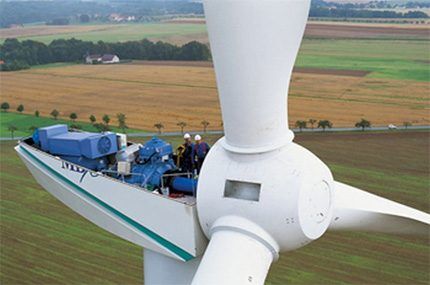
What is noteworthy is that this process is long-term in nature (at least 1 month), which is quite obvious. It is impossible to calculate the maximum probable parameters of wind speed and its most frequent direction with one or two measurements.
Dozens of measurements will be required. However, this operation is really necessary if there is a desire to build an effective productive system.
How to calculate the power of a windmill
Wind generators for domestic use, especially those made by hand, have never surprised people with high power. This is understandable. One has only to imagine a massive mast 8-10 m high, equipped with a generator with a propeller blade span of more than 3 m. And this is not the most powerful installation. Just about 2 kW.
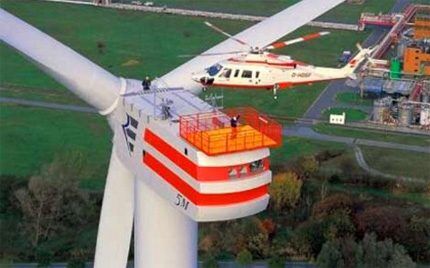
In general, if you rely on a standard table showing the relationship between the power of a wind generator and the required span of the propeller blades, there is something to be surprised about. According to the table, a 10 W windmill requires a two-meter propeller.
A 500-watt design will require a propeller with a diameter of 14 m. Moreover, the blade span parameter depends on their number. The more blades, the smaller the span.
But this is just a theory, conditioned by wind speeds not exceeding 4 m/sec.In practice, everything is somewhat different, and the power of household installations that actually operate for a long time has never exceeded 500 W.
Therefore, the choice of power here is usually limited to the range of 250-500 W with an average wind speed of 6-8 m/sec.
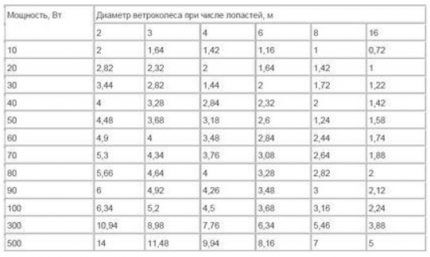
From a theoretical position, the power of a wind power station is calculated using the formula:
N=p*S*V3/2,
Where:
- p – density of air masses;
- S – total blown area of the propeller blades;
- V — air flow speed;
- N – air flow power.
Since N is a parameter that radically affects the power of a wind generator, the actual power of the installation will be close to the calculated value of N.
Calculation of wind turbine propellers
When constructing a windmill, two types of propellers are usually used:
- winged — rotation in the horizontal plane;
- Savonius rotor, Darrieus rotor — rotation in a vertical plane.
Screw designs with rotation in any plane can be calculated using the formula:
Z=L*W/60/V
Where:
- Z – degree of speed (low speed) of the propeller;
- L – the size of the length of the circle described by the blades;
- W – speed (frequency) of rotation of the propeller;
- V – air flow speed.
Based on this formula, you can easily calculate the number of revolutions W - rotation speed.
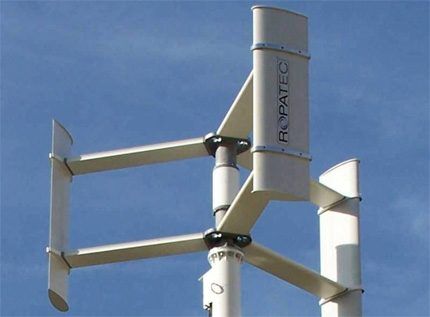
And the working relationship between revolutions and wind speed can be found in tables that are available on the Internet. For example, for a propeller with two blades and Z=5, the following relation is valid:
| Number of blades | Degree of speed | Wind speed m/s |
| 2 | 5 | 330 |
Also, one of the important indicators of a windmill propeller is the pitch.
This parameter can be determined using the formula:
H=2πR* tan α,
Where:
- 2π – constant (2*3.14);
- R – radius described by the blade;
- tan α – section angle.
Additional information on choosing the shape and number of blades, as well as instructions for their manufacture, is provided in this article.
Selection of generators for wind turbines
Having the calculated value of the number of screw revolutions (W), obtained using the method described above, you can already select (manufacture) the appropriate generator.
For example, with a degree of speed Z=5, the number of blades equal to 2 and a speed of 330 rpm. At a wind speed of 8 m/s. The generator power should be approximately 300 W.
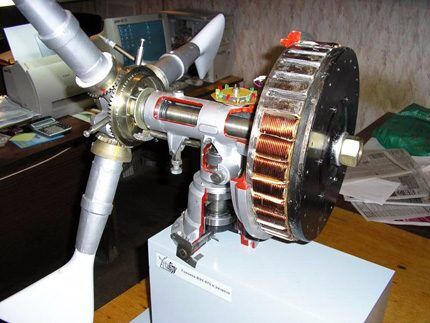
Given these parameters, a suitable choice as a generator for a domestic wind power plant may be the motor used in the designs of modern electric bicycles. The traditional name of the part is bicycle motor (made in China).
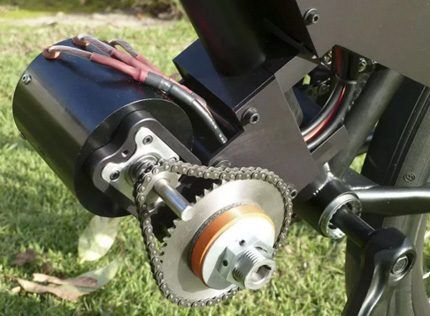
The characteristics of an electric bicycle motor are approximately as follows:
| Parameter | Values |
| Voltage, V | 24 |
| Power, W | 250-300 |
| Rotation speed, rpm. | 200-250 |
| Torque, Nm | 25 |
A positive feature of bicycle motors is that they practically do not need to be altered. They were structurally designed as low-speed electric motors and can be successfully used for wind generators.
To make a windmill you can use car generator or collect washing machine unit.
Calculation and selection of charge controller
A battery charge controller is required for any type of wind power plant, including a domestic design.
The calculation of this device comes down to selecting the electrical circuit of the device, which would correspond to the design parameters of the wind system.
Of these parameters, the main ones are:
- rated and maximum voltage of the generator;
- maximum possible generator power;
- maximum possible battery charging current;
- battery voltage;
- ambient temperature;
- ambient humidity level.
Based on the presented parameters, charge controller assembly do it yourself or select a ready-made device.
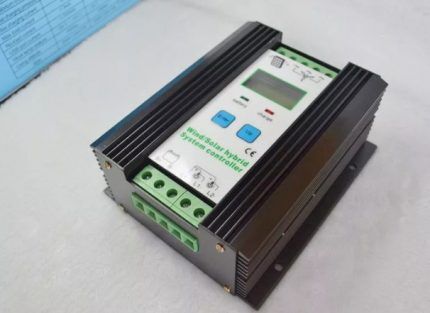
Of course, it is advisable to select (or assemble) a device whose circuit would provide an easy start function in conditions of weak air flows. A controller designed for operation with batteries of different voltages (12, 24, 48 volts) is also welcome.
Finally, when calculating (selecting) the controller circuit, it is recommended not to forget about the presence of such a function as inverter control.
Selecting a battery for the system
In practice, different types of batteries are used and almost all are quite suitable for use as part of a wind energy system. But a specific choice will have to be made in any case. Depending on the parameters of the windmill system, the battery is selected based on voltage, capacity, and charging conditions.
Traditional components for home windmills are classic lead-acid batteries. They showed good results in a practical sense.In addition, the cost of this type of battery is more reasonable compared to other types.
Lead-acid batteries are particularly unpretentious to charge/discharge conditions, but it is unacceptable to include them in a system without a controller.
If the wind turbine installation contains a professionally designed charge controller with a full-fledged automation system, it seems rational to use AGM or helium batteries.
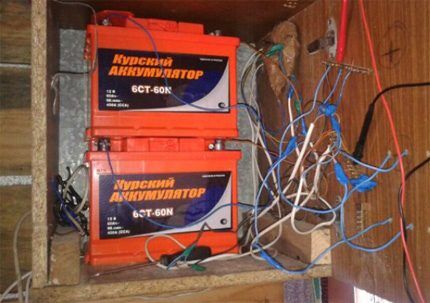
Both types of energy storage devices are characterized by greater efficiency and a long service life, but they place high demands on charging conditions.
The same applies to the so-called armored helium-type batteries. But the choice of these batteries for a household windmill is significantly limited by price. However, the service life of these expensive batteries is the longest compared to all other types.
These batteries also have a longer charge/discharge cycle, but only if a high-quality charger is used.
Calculation of an inverter for a home windmill
It should be noted right away: if the design of a home wind turbine contains one 12-volt battery, there is no point in installing an inverter on such a system.
On average, household power consumption is at least 4 kW at peak loads.Hence the conclusion: the number of rechargeable batteries for such power should be at least 10 pieces and preferably with a voltage of 24 volts. For such a number of batteries it makes sense to install an inverter.
However, to fully provide energy to 10 batteries with a voltage of 24 W each and stably maintain their charge, a windmill with a power of at least 2-3 kW will be required. Obviously, simple household structures cannot handle such power.
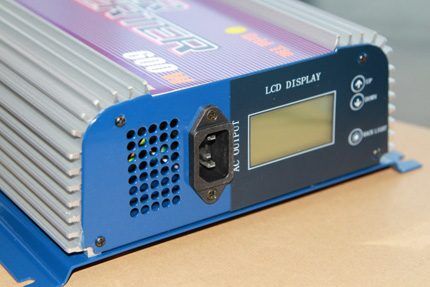
However, you can calculate the inverter power as follows:
- Sum up the power of all consumers.
- Determine the time of consumption.
- Determine peak load.
In a specific example it will look like this.
Let there be household electrical appliances as a load: lighting lamps - 3 pcs. 40 W each, television receiver - 120 W, compact refrigerator 200 W. We sum up the power: 3*40+120+200 and we get 440 W at the output.
Let's determine the power of consumers for an average period of 4 hours: 440*4=1760 W. Based on the obtained power value over time of consumption, it seems logical to select an inverter from among such devices with an output power of 2 kW or more.
Based on this value, the current-voltage characteristic of the required device is calculated: 2000*0.6=1200 V/A.
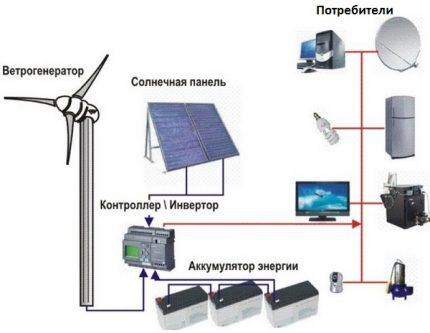
In reality, the household load on a family of three people, which is fully equipped with household appliances, will be higher than calculated in the example. Typically, the load connection time also exceeds the required 4 hours. Accordingly, the wind power system inverter will need a more powerful one.
Preliminary calculation of a windmill is useful not only for its self-assembly. It is also necessary to determine the optimal parameters when choosing a ready-made wind generator.
Conclusions and useful video on the topic
How the source data is analyzed and how the formulas are applied is presented in the video:
It is necessary to use calculated data in any case. Whether it is an industrial power plant or one manufactured for domestic use, the calculation of each unit always ensures maximum efficiency of the device and, most importantly, operational safety.
Preliminary calculations determine the feasibility of implementing the project and help determine how costly or economical the project is.
Do you have experience in solving similar problems? Or still have questions on the topic? Please share your wind turbine calculation and design skills. You can leave comments and ask questions in the form below.




In short, it is very clear that if you are not an engineer, then it is better not to even take on making a homemade windmill. Wasted time and money. Now, with ready-made elements, if you buy a windmill, batteries, and inverter controller separately, almost anyone with hands growing in the right place can figure it out, and this will be the best option.Well, if you have a lot of money, you can order installation with all the equipment together.
But why. If you have the desire and access to the Internet, then you can really figure it out without being an engineer. In extreme cases, you will lose a little efficiency.
The story is good and bad, what are the steps to the water mill?